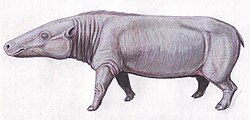Anthracotherium
Extinct genus of mammals From Wikipedia, the free encyclopedia
Anthracotherium, from Ancient Greek ἄνθραξ (ánthrax), meaning "coal", and θηρίον (theríon), meaning "beast",[3] is an extinct genus of artiodactyls characterized by having 44 teeth, with five semi-crescentic cusps on the crowns of the upper molars. The genus ranged from the middle Eocene period until the early Miocene, having a distribution throughout Eurasia.[4] Material subjectively assigned to Anthracotherium from Pakistan suggests the last species died out soon after the start of the Miocene.[1]
| Anthracotherium | |
|---|---|
 | |
| Anthracotherium magnum skull and jaws | |
| Scientific classification | |
| Domain: | Eukaryota |
| Kingdom: | Animalia |
| Phylum: | Chordata |
| Class: | Mammalia |
| Order: | Artiodactyla |
| Suborder: | Whippomorpha |
| Family: | †Anthracotheriidae |
| Subfamily: | †Anthracotheriinae |
| Genus: | †Anthracotherium G. Cuvier, 1822 |
| Species | |
Description
The genus typifies the family Anthracotheriidae, if only because it is the most thoroughly studied. In many respects, especially the anatomy of the lower jaw, Anthracotherium, as with the other members of the family, is allied to the hippopotamus, of which it is probably an ancestral form.[4] The Anthracotheres, together with the hippos, are grouped with the cetaceans in the clade Whippomorpha. Anthracotheriinae are characterized by three non-ambiguous features, which is their crown height development of the lower canine, and the presence of accessory cristulids from the hypoconulid, posthypocristulid, and labial on the lower and upper molars. [5] With these features into consideration, it has been found that these anthracotheres are in three dietary categories of extant herbivores: leaf browsers, fruit browsers, and grazers.[6]
Etymology
The genus name stems from the fact that the holotype and other first specimens were originally obtained from the Paleogene (previously known as "Tertiary")-aged lignite beds of Europe.[4]
The European Anthracotherium magnum was approximately as large as a pygmy hippo (about 2 m long and weighing up to 250 kg), but there were several smaller species and the genus also occurs in Egypt, India and North America.[4][7] Members of the genus Anthracotherium, as well as other members of the family Anthracotheriidae, are known colloquially as anthracotheres.
- Anthracotherium magnum
- Anthracotherium sp. coprolite at the Museum für Naturkunde, Berlin
References
Wikiwand - on
Seamless Wikipedia browsing. On steroids.
